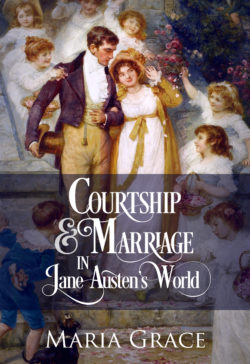Honeymoons and Bridal Visits

Today when we think of weddings, we often conceive of a honeymoon as well. In Austen’s day, couple did travel after their wedding, but their trips often served a very different purpose. It was not unusual for one relatives to have never met one’s new spouse. These visits often remedied this situation.
Honeymoons
After the wedding and possibly the breakfast, a newlywed couple would usually go to the husband’s house. If the couple planned a wedding trip, they usually departed a week or so later.
In Austen’s day, the war with France (and finances for most people) made touring the continent out of the question, couples of the era usually planned trips closer to home. They might visit relations to make introductions (and cut down on travel costs) or visit picturesque landscapes like the Lake District or Peaks or seaside resorts like Brighton.
Often, the bride’s sister or closest female friend accompanied the couple, as Julia did Maria in Mansfield Park. To the modern eye the custom seems weird at best, but since the bride and groom might have spent little time alone with one another prior to the wedding, relying only on one another for conversation and company during a trip could be very awkward. Having another person along could ease the transition for everyone.
Stating Married Life: Bridal Visits
When a couple arrived home, important social obligations in the form of social calls would begin. Typically, neighbors would call upon the new bride, often having first received one of her nuptial cards that provided information including her new name, address, when the couple would be on their bridal travels, and the days she would be available to receive callers. A bride could expect a month of more of exchanging visits and attending dinners and events in her honor as she became acquainted with her new community and learned her place in it.
In Austen’s Emma, the new vicar’s wife, Mrs. Elton makes the most of her elevated status. She takes precedent over Emma at social events and has dinners and parties held in her honor. As a married woman, she does rank higher than an unmarried one, but her new bride status lends her a special, temporary, elevation in social rank.
On the whole, married women enjoyed a position in society that the unmarried, spinsters and widows, could not aspire to. That’s one reason that ‘Mrs.’ was used as an honorific for unmarried ladies who had proven their worth in other ways, like senior servants in a household. Mrs. Hill and Mrs. Reynolds of Pride and Prejudice might not ever have actually been married.
A woman’s life and identity totally changed at marriage. The bridal visits marked the start. Tell me what you think in the comments.
Find References Here!
To Read more articles on weddings, click here.
To read more articles on courtship click here.
To read more articles on marriage click here.
If you enjoyed this post, you might enjoy this book:

While visiting relatives may seem strange in today’s custom of expensive exotic honeymoons, sometimes it resulted in lifelong memories. Fifty years ago, my husband’s best friend took his bride to meet a distant relative, Norman Rockwell, and it was an incredibly special visit they couldn’t stop talking about. My own parents married in 1934 with little money and spent part of their honeymoon in great splendor as guests of his godfather, the Bishop of Bath and Wells., at the 800-year-old Bishop’s palace in Wells. Check out the pictures by Googling “Bishop’s Palace, Wells”; it looks like somewhere you could come upon Mr Darcy unawares.
“As a married woman, she does rank higher than an unmarried one, but her new bride status lends her a special, temporary, elevation in social rank.”
This sentence made me think of Lydia and the main reason she wanted to marry first. She wanted precedence over her sisters. When they went to dinner, Lydia was quick to tell Jane that she was now lower because Lydia was a married woman. Help us all. That poor child has no idea what she has done.
Thanks for these snippets. I hope you have recovered from all the harsh weather. Stay safe and healthy.
Interesting. I have been called “Miss Sheila” in my work as a caseworker. So even in modern days the terms have use not indicating a married or unmarried status. Thanks for sharing here.
its not just the honeymoon that has changed, but almost all the celebratory special stuff because you are a bride has also shifted into a prewedding schedule crammed full of travel and socialising, on top of the wedding planning and while trying not to use up your vacation days from work (if you have any) making such travel and socialising that much less relaxing as you skip your lunch hours to leave early, or stress to get home no matter how late on Sunday in order to be able to get into work on Monday. It probably contributes to the modern stereotype of ‘bridezilla’ by both over emphasising the engagement phase and multiplying the stress.
Nicer, really, to incorporate some of that travel into the honeymoon, and some of those parties into the first weeks or months of marriage.